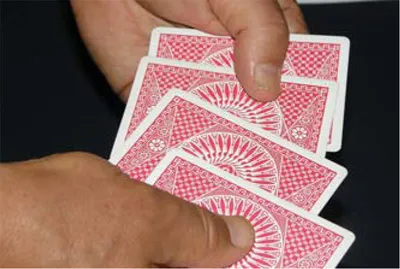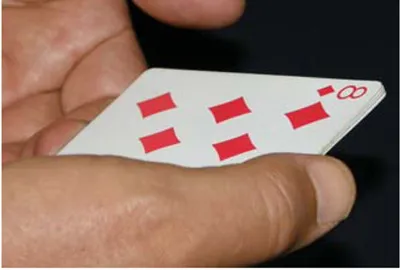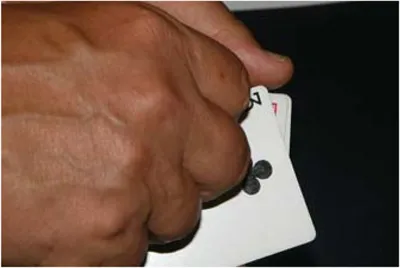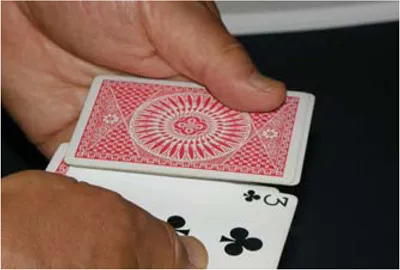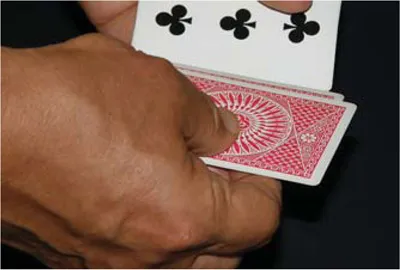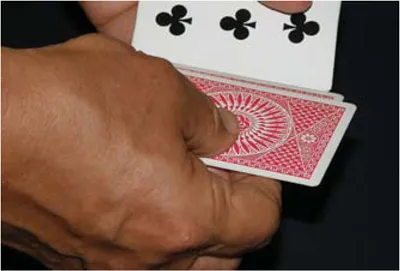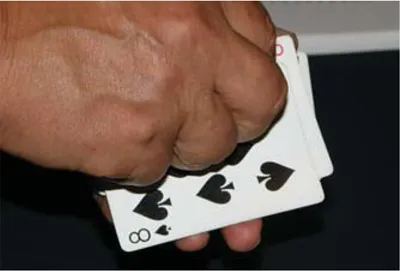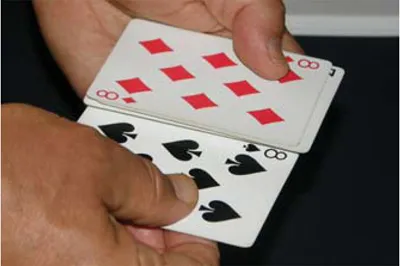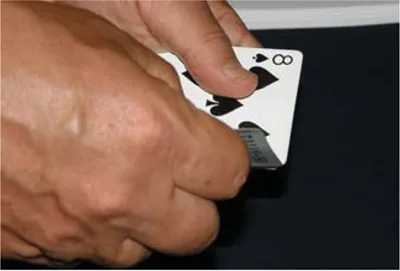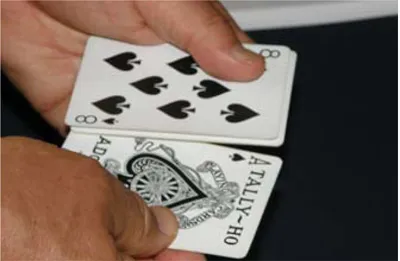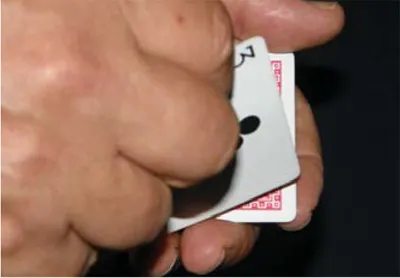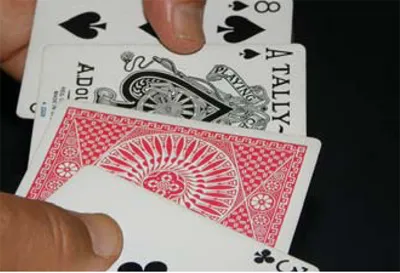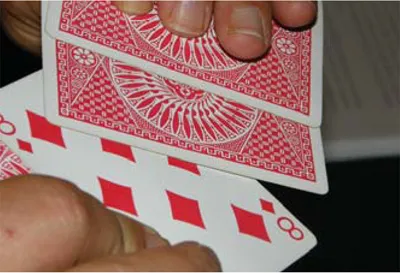![]()
Chapter 1
MATHEMATICS IN THE AIR
Most mathematical tricks make for poor magic and in fact have very little mathematics in them. The phrase “mathematical card trick” conjures up visions of endless dealing into piles and audience members wondering how long they will have to sit politely. Our charge is to present entertaining tricks that are easy to perform and yet have interesting mathematics inside them. We cannot do this without your help. To get started, please go find four playing cards. They can be any four cards, all different or the four aces. It doesn’t matter. Let us begin by performing the trick for you. Since we can do it without being present, you’ll be able to do it for a friend on the phone. After practicing, try calling your kid brother or your mom and perform the following.
Figure 1. Four cards
Figure 2. Four cards in a packet
Figure 3. Looking at bottom card
Have a look at the bottom card of the packet. That’s your card and you have to remember it.
Figure 4. Top card placed on bottom
Figure 5. Current top card turned face-up
Next, the cards are going to be mixed by some simple instructions. Put the top card on the bottom of the packet. Turn the current top card face-up and place it back on top.
Figure 6. Cutting the deck
Figure 7. Spreading off and turning over the top two
Now, give the packet a cut. It doesn’t matter how many cards you cut from top to bottom: one, two, three, or four (which is the same as none). Next, spread off the top two cards, keeping them together, and turn them over, placing them back on top.
Figure 8. Cutting again
Figure 9. Turning over two again
Figure 10. Another cut
Figure 11. Turning over two
Cut the cards at random again and then turn the top two over. Give them another cut and turn two over.
Give them a final cut. This cutting and turning has mixed the cards in a random fashion. There is no way anyone can know the order. Remember the name of your card! We’re going to find it together.
Figure 12. Turning over the top card
Figure 13. Putting it on the bottom
Turn the top card over (if it’s face-down, turn it face-up; if it’s face-up, turn it face-down). Put this card on the bottom of the packet.
Figure 14. Putting the top card on the bottom
Figure 15. Turning over the top card bottom
Put the current top card on the bottom of the packet without turning it over. Finally, turn the top card over and place it back on top.
Figure 16. The “oddball” card
Figure 17. The chosen card
Now, we’re done. Name your card. Spread out the packet of four. You’ll find three cards facing one way and your card facing the opposite way!
When we perform this trick with a live audience in the same room, we try to work it on a man with a tie or a woman with a scarf. We give him or her the four cards with instructions to shuffle, peek at the bottom card, and follow the instructions above until he or she has cut and turned over two a few times. We then ask our subject to put the four cards behind his or her back. The rest of the instructions are carried out with the cards concealed this way. When the cutting and turning phase is finished, we stare intently at the person’s midsection in giving the final two steps of instructions as if we were looking through our subject. Before the final line of instruction we reach over and move the tie or scarf as if it were blocking our view. We have him or her name the card before bringing out the packet.
We have used this trick for an audience of a hundred high school students—each student received a packet of four cards, and the trick was worked simultaneously for all of them. It’s a charming trick and really seems to surprise people.
Okay. How does it work? Let’s start by making that your problem: How does it work? You’ll find it curiously difficult to give a clear explanation. In twenty years of teaching, asking students to try to explain this trick, we have yet to have anyone give a truly clear story. The plan is to lead you through this in stages (it has some math in it). The solution comes later in this chapter. Before proceeding, let’s generalize.
The trick is known as Baby Hummer in magic circles. It was invented by magician Charles Hudson as a variation on an original trick by a truly eccentric genius named Bob Hummer. We’ll learn a lot more about Hummer as we go along. Here is his original use of the principle we’re trying to explain.
Take any ten cards. Have them all face-down and hold them as if you were about to deal in a card game. Go through the following procedure, which mixes the cards face-up and face-down: Spread the top two cards off and turn them over, placing them back on top. Give the cards a straight cut (see figure 6). Repeat this “turn two and cut at random” procedure as often as you like. The cards will be in an unpredictable mess. To find the order in the mess, proceed as follows: Go through the packet, reversing every second card (the cards in positions 2, 4, 6, 8, and 10). You will find exactly five cards face-up, no matter how many times the “turn two and cut at random” procedure was repeated.
Hummer marketed this trick in a privately printed manuscript called “Face-up/Face-down Mysteries” (1942).1 This ten-card trick does not play as well for audiences as the Baby Hummer we started with. Hummer introduced a kind of swindle as a second phase. After showing that five cards are face-up and five cards are face-down, casually rearrange the cards so that the face-up and face-down cards alternate up, down, up, down, and so on. Hand the ten cards to a spectator who is instructed to put the cards under the table (or behind his or her back). Have the spectator repeat the “turn two and cut at random” procedure a few times. Take the cards back without looking at them. Now, with the cards under the table (or behind your back), remove every second card as before and turn them over. You will find that the cards all face the same way.
Figure 18. Reversing every second card
Again, one may ask, why does this work? Just what properties of the arrangement are preserved by Hummer’s “turn two and cut at random”procedure? To think about Hummer’s “turn two and cut at random” mixing scheme, we find it helpful to have a way of writing down all the possible arrangements that can occur. Instead of working with a deck of four or ten cards, one can just as easily work with a general deck of even size. We work with 2n cards (so, if n = 2 then 2n = 4, or if n = 5 then 2n = 10). As will be seen in a while, decks of odd size are a different kettle of fish. We can indicate the exact arrangement of 2n cards, some faceup and some face-down, by writing the numbers on the cards in order and identifying face-u...

